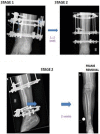Is a staged reloading protocol effective to time the removal of circular frames? : a retrospective analysis
- PMID: 35491551
- PMCID: PMC9134831
- DOI: 10.1302/2633-1462.35.BJO-2021-0179.R1
Is a staged reloading protocol effective to time the removal of circular frames? : a retrospective analysis
Abstract
Aims: The timing of when to remove a circular frame is crucial; early removal results in refracture or deformity, while late removal increases the patient morbidity and delay in return to work. This study was designed to assess the effectiveness of a staged reloading protocol. We report the incidence of mechanical failure following both single-stage and two stage reloading protocols and analyze the associated risk factors.
Methods: We identified consecutive patients from our departmental database. Both trauma and elective cases were included, of all ages, frame types, and pathologies who underwent circular frame treatment. Our protocol is either a single-stage or two-stage process implemented by defunctioning the frame, in order to progressively increase the weightbearing load through the bone, and promote full loading prior to frame removal. Before progression, through the process we monitor patients for any increase in pain and assess radiographs for deformity or refracture.
Results: There were 244 frames (230 patients) included in the analyses, of which 90 were Ilizarov type frames and 154 were hexapods. There were 149 frames which underwent single-stage reloading and 95 frames which underwent a two-stage reloading protocol. Mechanical failure occurred after frame removal in 13 frames (5%), which suffered refracture. There were no cases of change in alignment. There was no difference between refracture patients who underwent single-stage or two-stage reloading protocols (p = 0.772). In all, 14 patients had failure prevented through identification with the reloading protocol.
Conclusion: Our reloading protocol is a simple and effective way to confirm the timing of frame removal and minimize the rate of mechanical failure. Similar failure rates occurred between patients undergoing single-stage and two-stage reloading protocols. If the surgeon is confident with clinical and radiological assessment, it may be possible to progress directly to stage two and decrease frame time and patient morbidity. Cite this article: Bone Jt Open 2022;3(5):359-366.
Keywords: CT scanning; Clinicians; Mechanical failure; Nonunion; Refracture; deformity; dynamization; failure; fracture sites; frame removal; hexapod; ilizarov; morbidity; nonunion; radiography; refracture; reloading; trauma.
Conflict of interest statement
Figures



References
-
- Jabbar Y, Jeyaseelan L, Khaleel A. Staged complete dynamisation of the Ilizarov fixator: the Chertsey experience. Eur J Orthop Surg Traumatol. 2011;21(7):521–526. 10.1007/s00590-010-0746-x - DOI

